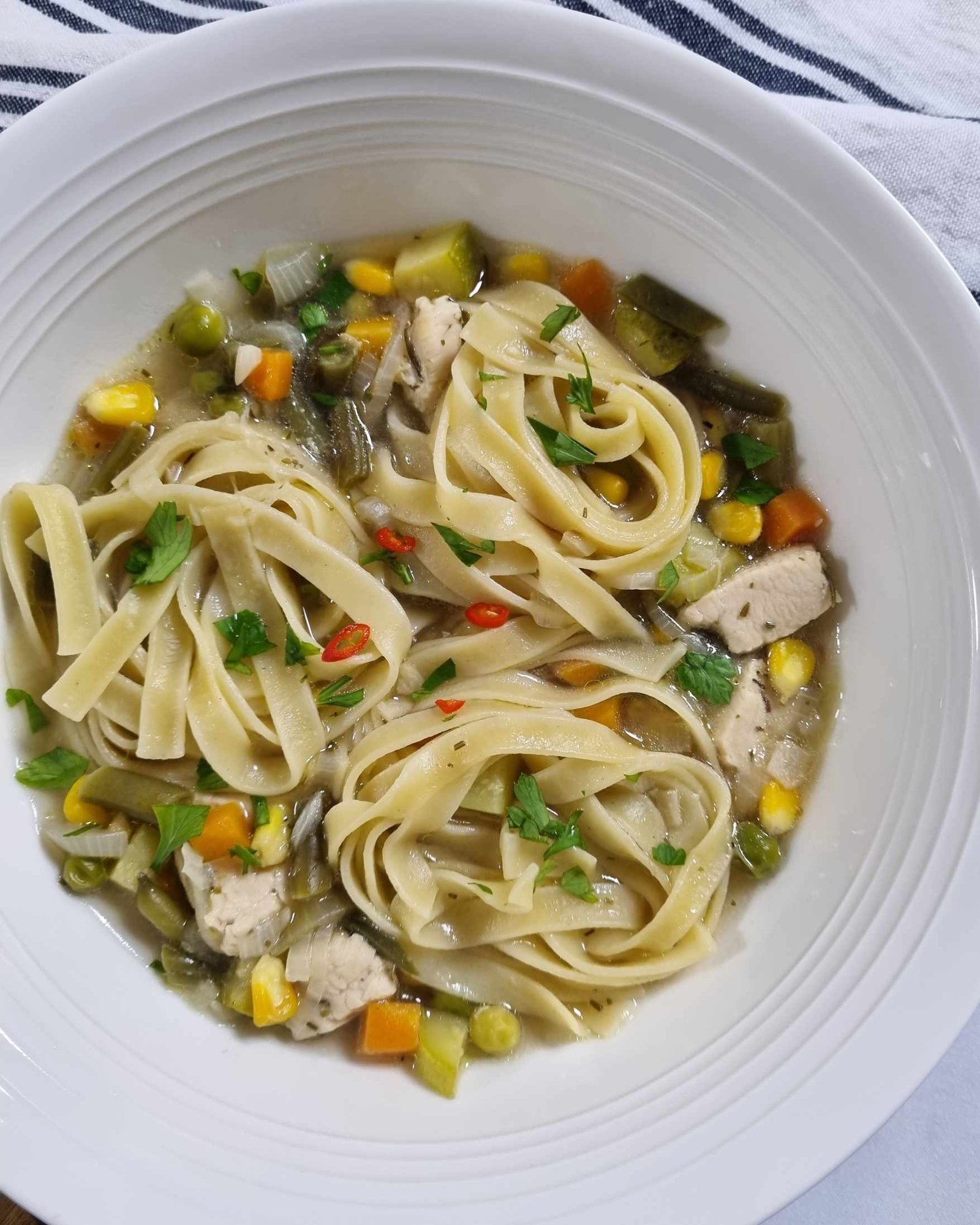
Newsletter Subscribe
Enter your email address below and subscribe to our newsletter

Enter your email address below and subscribe to our newsletter
Who’s ready to indulge in a warm and delightful bowl of Chicken Noodle Soup? This version of the classic dish sets itself apart from the other chicken soups; we’ve created a dish full of rich flavours, making it a beloved remedy for those chilly days.
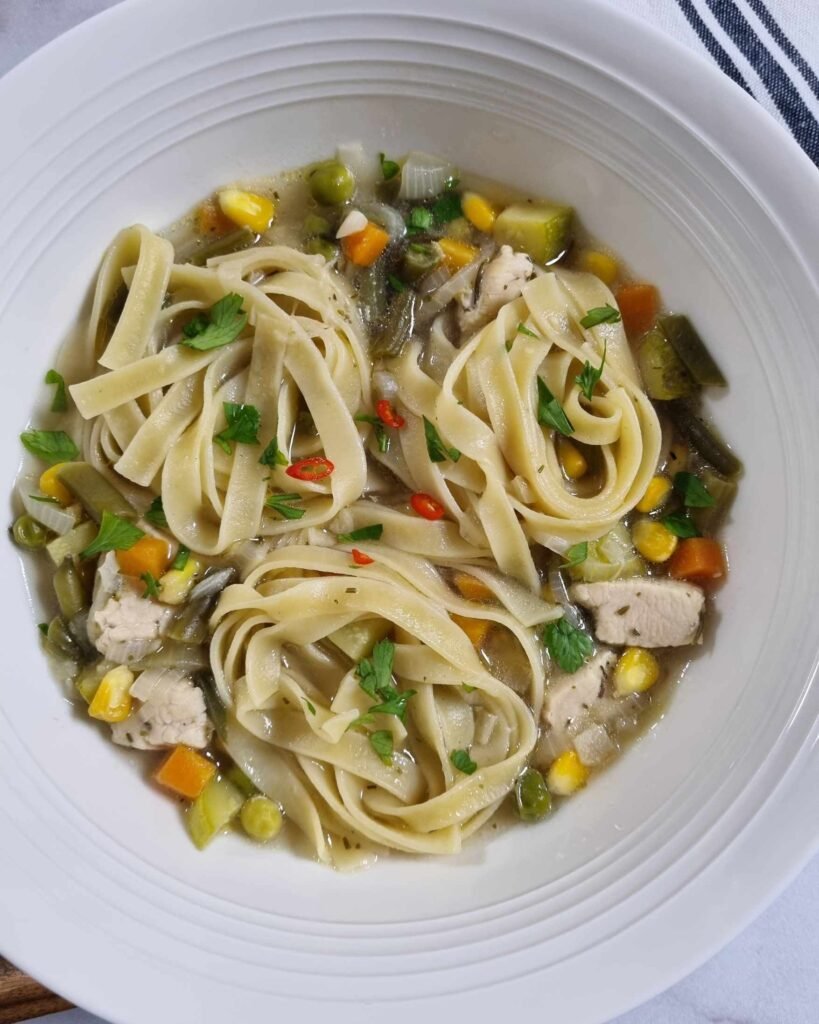
Enjoyed worldwide, Chicken Noodle Soup is the go-to choice for an uplifting bowl of goodness. In this recipe, we’ll use tender chicken thighs and aromatic herbs to create a delightful balance of flavours that is nothing short of pure happiness.
Chicken Soup originated from China, where people have been eating it for thousands of years. In fact, they’re so fond of this poultry dish that they have adapted it and added chili flakes and chili oil, which makes it a spicy delight.
In contrast, in South Korea, the Koreans add roots and dates to create a balanced meal, which is often enjoyed with Spicy Kimchi and other side dishes. Moreover, Western and European countries created a more subdued version of Chicken noodle soup with vegetables such as carrots, onion, turnips, herbs, and leftover chicken. All cultures will have their own variation of this dish. It is a hearty meal that is deeply nourishing in the Winter and Autumn months, and many people attest to its amazing ability to help the body recover whenever it needs that extra boost of protein and chicken broth that occurs naturally when cooking chicken with vegetables in a soup.
Chicken breast, Tagliatelle, Water, Cooking oil, Frozen mixed vegetables, Onion, Garlic cloves, Zucchinis, Garlic powder, Onion powder, Ground White pepper, Dried Rosemary, Dried Thyme, Chicken stock cube, Bay leaves and Salt.
You can use chicken breast, thighs or a whole chicken for this soup. Tagliatelle is ideal for this soup, egg noodles, fettucine and other types of noodles and pastas can also be used for this recipe. Frozen vegetables are convenient and require minimal preparation when it comes to this dish, you can also chop up your favourite combination of vegetables for this recipe. Consider vegetables such as bell peppers, celery, potatoes, parsnips, and cabbage, in place of the vegetables listed above.
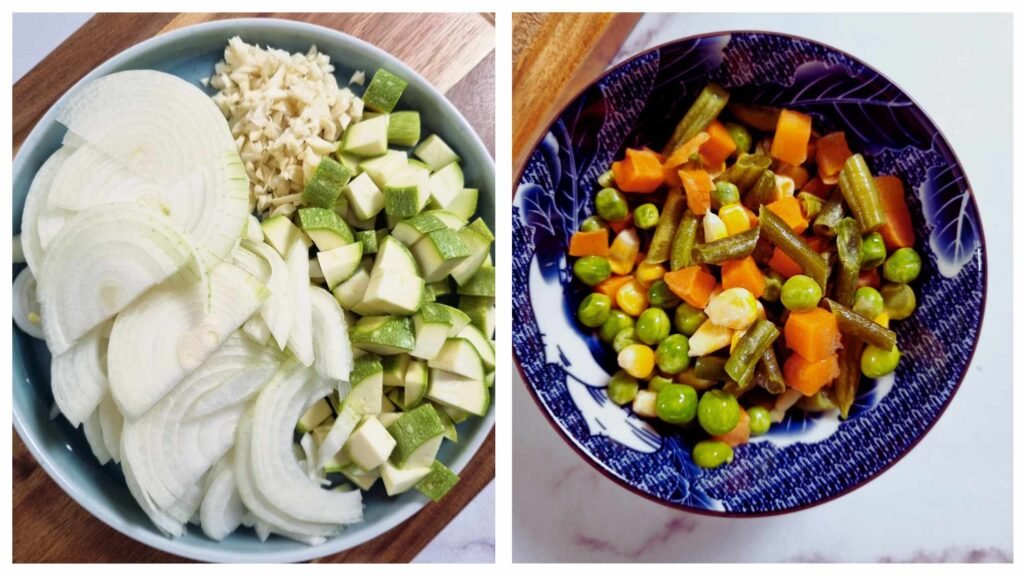
Onions and garlic cloves add a savoury flavour to the soup. Spices are used sparingly in the chicken soup, however they add a lot of flavour to the dish. Garlic and onion powder enhance the recipe, ground white pepper adds a little heat. Whereas herbs such as rosemary and thyme pair well with chicken. Bay leaves has an earthy flavour with slight herbal notes.
Slice the onions, roughly chop up the garlic cloves, and cube the zucchinis. The frozen vegetables used in this recipe contain carrots, green beans, peas, and sweet corn. Onion, carrot, and sweet corn add a hint of sweetness to the soup, whilst other vegetables provide plant-based protein and enhance the overall flavour of the soup.
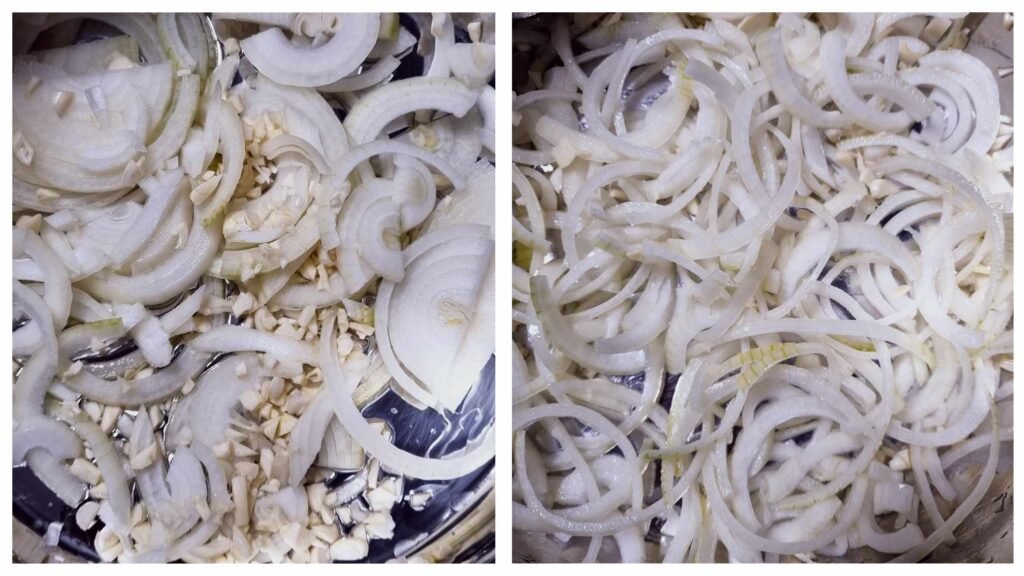
Cut the chicken into bite-sized pieces or half-inch cubes. Also, prepare the spices, such as ground white pepper, onion powder, garlic powder, dried thyme, dried rosemary, and a chicken stock cube. Preheat a pot to medium-low temperature. Drizzle the cooking oil, add the onion and garlic. Toss them around so the aromatics are evenly coated with oil. Cook the onion and garlic for four minutes, or until they begin to brown.
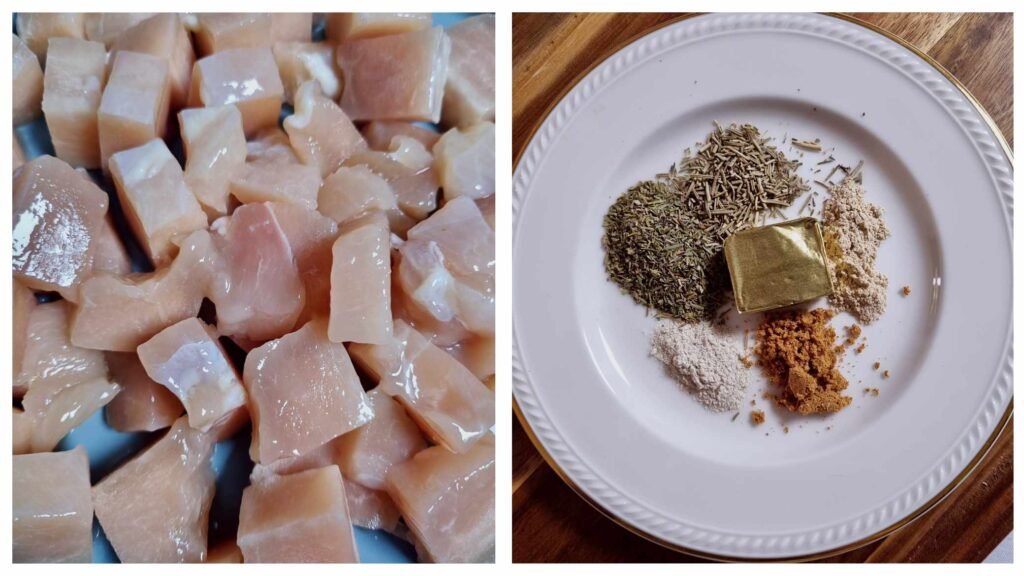
Toss in all the remaining ingredients into the pot, a quarter cup of water, and then stir to mix. Continue to stir everything and cook the ingredients until all the chicken turns white in colour.
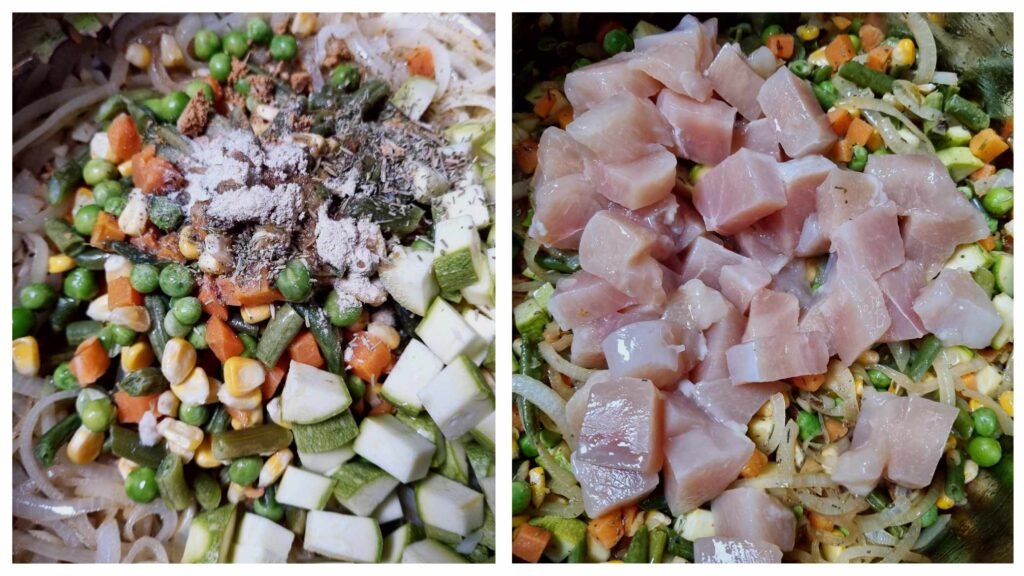
Add the chicken stock cube, bay leaves, and one and a half litres of water to the pot. Then, simmer the soup for thirty minutes, on medium-low heat, with the lid closed. Add the noodles to the soup in the last nine minutes of simmering.
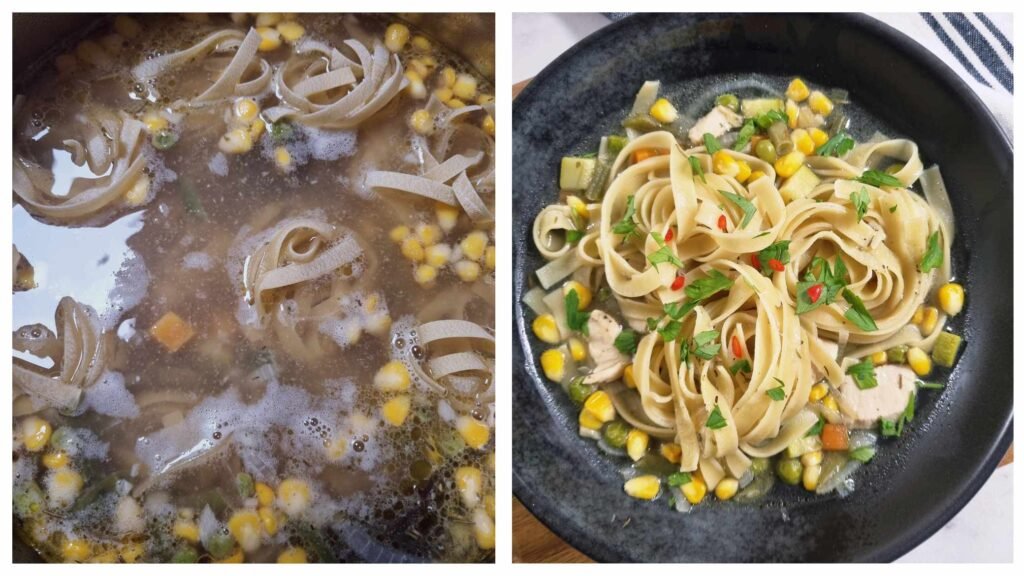
Garnish with parsley and bits of red chili, and enjoy this quick and easy chicken noodle soup.
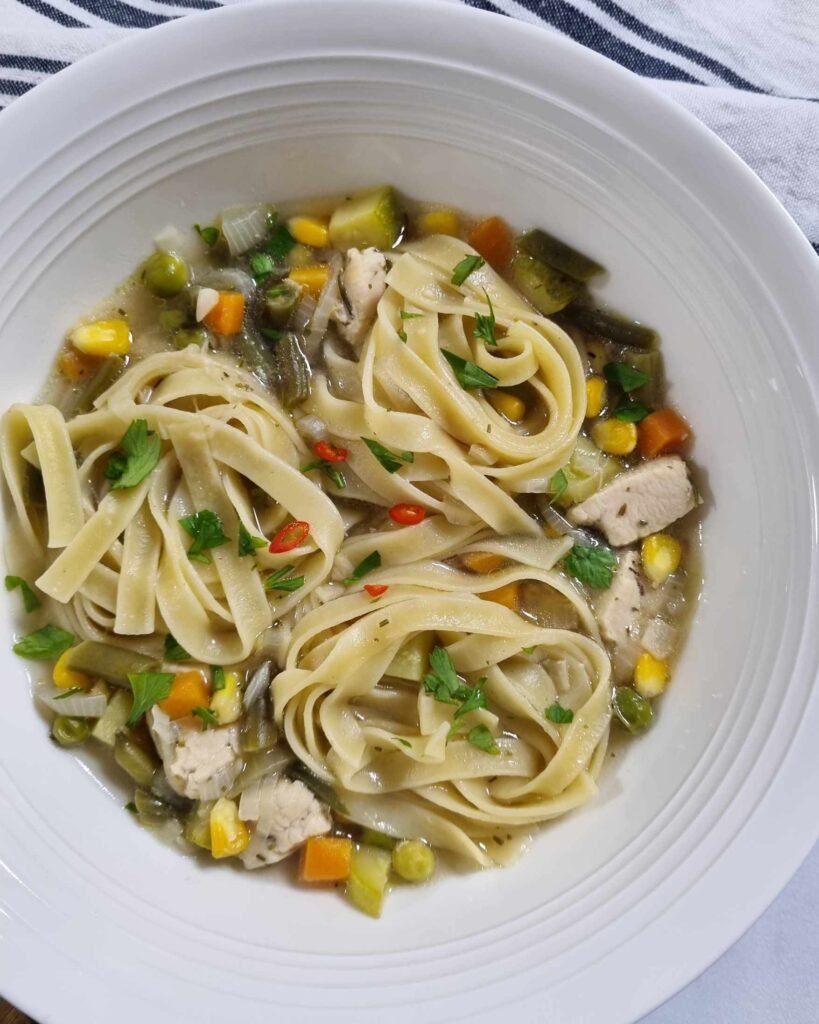
If possible, use bone-in chicken thighs for extra flavour. They will enhance the soup’s taste. The chicken can easily be shredded during the cooking process. You can also use chicken breast in this recipe, which is a lean meat cut. Contrary to what most people think, the chicken breast won’t be tough; it will actually be tender and soft when it is cooked in the soup.
Sauté the vegetables first, then cook the soup. Sautéing vegetables like onion, garlic, and carrot will intensify the soup’s flavour. In place of white radish, you can add a turnip instead. Make sure to add the noodles or pasta at the end of the cooking process. Adding the noodles early will make the pasta soggy as it will absorb too much liquid. Cook the pasta for nine minutes until it is al dente. Check the instructions on the packet.
Chicken noodle soup is healthy, nourishing, and comforting. Since the chicken is cooked with bone-in pieces, the nutrients from the bones are also extracted into the soup. Chicken meat is an excellent protein source, essential for muscle growth and repair, and contributes to the immune system. The diversified vegetables and herbs in the chicken soup, such as carrot, onion, garlic, white radish, bell pepper, paprika powder, and bay leaves, provide various vitamins, minerals, fibres, and antioxidants. These factors aid in digestion, boost the immune system, and enhance overall bodily functions.
The broth of chicken soup is packed with nutrition from the vegetables, herbs, and spices, as well as the collagen released from the chicken bones. The soup’s liquid content also hydrates the body, and the combination of these ingredients is especially nourishing for people recovering from the flu or a cold. The warmth of the soup also promotes relaxation, helps to soothe a sore throat, and brings comfort by reducing stress and anxiety. This hearty soup is most appreciated during the cold seasons or if you’re recovering from the flu.
Yes, it is perfectly okay to put the uncooked noodles or pasta in the chicken soup, as they will cook within the soup. Also, the noodles will absorb the soup’s flavour and thicken it. This is a convenient way of cooking chicken soup because you don’t have to cook the noodles separately, drain the water, and transfer the noodles into the pot.
When the noodles are cooked in the soup, the starch released from the pasta will naturally make the soup thicker. If you wish to thicken the soup further, mix an equal amount of corn-starch and cold water and add the slurry. Add a teaspoon of white flour or instant potato flakes to the soup. These ingredients will thicken the soup without altering its flavour.
Chicken noodle soup has many benefits for those who are dealing with a cold or flu. The broth can provide hydration, and when consumed hot, it warms the body. This soup is also perfect for individuals with a low appetite. It is comforting and nourishing. The protein from the chicken helps the immune system fight off the cold. Vegetables provide essential vitamins, minerals, and fibres to boost overall body function, and the carbohydrates from the pasta noodles provide energy to the body.
Crusty bread, like sourdough or a baguette, pairs wonderfully with chicken noodle soup. Dip the crusty bread into the soup to soak up the broth, making every bite bursting with flavors. Cornbread adds a touch of sweetness to the soup, balancing the taste of savory and sweet.
Chicken soup noodle is best enjoyed when made fresh; however, it can be served in the following days, as long as the noodles are not already cooked in the soup. If the noodle is already cooked and left inside the soup, they will expand by absorbing the liquid and become soggy and flavorless over time. The soup should be kept separately from the noodles, and cook more noodles when you want to enjoy the soup.
Bring the soup to room temperature before keeping it in the fridge. Then, transfer the soup into an airtight container and place it in the fridge. The soup can be stored in the refrigerator up to five days, and in the deep freeze for up to three months. To reheat the refrigerated or frozen soup, simply transfer the soup into a small pot, bring the soup to a boil, add the noodles, and then cook the noodles for nine minutes on medium-low heat.
